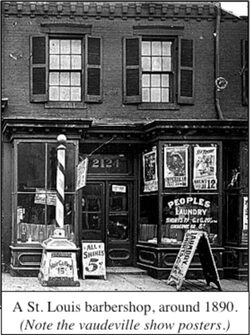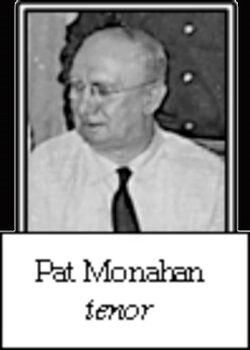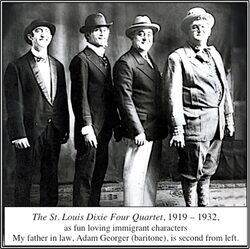My Family & Early Barbershop Music
 It is still a mystery exactly how Barbershop music was formed. It is a uniquely American style of music, but it used music forms that were well-established in Europe before the 1800s. However, the unique sound of Barbershop comes from having the melody in the second tenor part. European music usually put the melody in the first tenor part in male quartets. Also the exaggerated use of the "Barbershop 7th chord" in close harmony formation would eventually give our music its special sound. My earliest memories of Barbershop quartet history came from my grandfather and later my father-in-law.
It is still a mystery exactly how Barbershop music was formed. It is a uniquely American style of music, but it used music forms that were well-established in Europe before the 1800s. However, the unique sound of Barbershop comes from having the melody in the second tenor part. European music usually put the melody in the first tenor part in male quartets. Also the exaggerated use of the "Barbershop 7th chord" in close harmony formation would eventually give our music its special sound. My earliest memories of Barbershop quartet history came from my grandfather and later my father-in-law.
BARBERSHOPS: As a chorus member- and actual barber- Ron Thebeau tells us, early barbers often did more than just cut hair and trim beards: tooth pulling, minor surgery, lance boils, clean out infections, give neck massages, cleaning of ears and scalp. Bloody rags used in these activities were hung on a pole to dry-- and representations of these poles became symbols of barbershops everywhere.
The "clean-cut" urban look was in. To keep that look, a haircut was needed at least every two weeks, and a close shave every single day. Until recently, the barbershop was a place where only men would gather, smoke cigars and cuss. (Surely gentleman readers can remember the first shocking time you saw a lady barber, or when they changed the name of your barbershop to "salon.")
 What was the old barbershop like? My grandfather, Pat Monahan, was born in St. Louis in 1889. When I asked him about quartets in barbershops, he said all the big barbershops in his St. Louis Irish neighborhood had pianos and informal quartets. Lots of guys could play piano. There would be stacks of sheet music for people to look at, and the sheet music often had quartet harmony written for the song on the back page. He said it was a natural thing to try to harmonize. The songs were written with the idea of being harmonized! (Of course, he said he was the BEST Irish tenor in the neighborhood, and the ladies would swoon over his rendition of "Danny Boy.") He said singing in four parts was hard to do, but everybody tried it anyway. Usually they could only do two, three, but sometimes four-part harmony. Grandpa said singing was almost always done with a
What was the old barbershop like? My grandfather, Pat Monahan, was born in St. Louis in 1889. When I asked him about quartets in barbershops, he said all the big barbershops in his St. Louis Irish neighborhood had pianos and informal quartets. Lots of guys could play piano. There would be stacks of sheet music for people to look at, and the sheet music often had quartet harmony written for the song on the back page. He said it was a natural thing to try to harmonize. The songs were written with the idea of being harmonized! (Of course, he said he was the BEST Irish tenor in the neighborhood, and the ladies would swoon over his rendition of "Danny Boy.") He said singing in four parts was hard to do, but everybody tried it anyway. Usually they could only do two, three, but sometimes four-part harmony. Grandpa said singing was almost always done with a piano.
piano.
VAUDEVILLE: Quartets had already been part of traveling minstrel shows throughout the 1800s but it was vaudeville that truly brought the barbershop style of music to the professional stage. My wife's father, Adam Georger, was born in the 1890s and formed a professional quartet named "the St. Louis Dixie Four" after his service in World War I. He told me they sang without microphones in vaudeville theaters throughout the Midwest on the "Orpheum Junior Circuit." They traveled by railroad. Often the quartet would be in a different town each night of the week. They always had a piano accompaniment with an occasional acapella song.
By Dan Monahan: Music Vice President, Spirit of St. Louis Chorus

